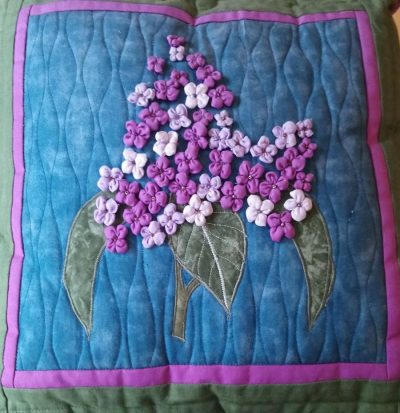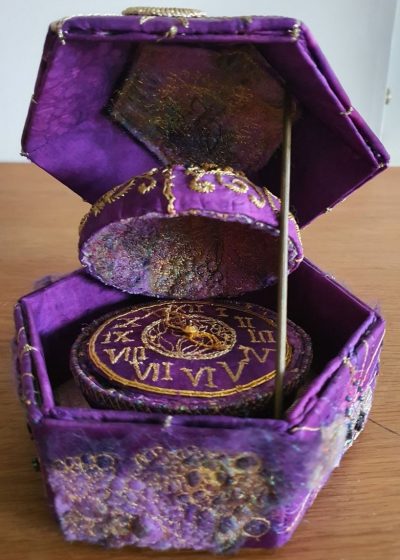 Thanks to Cobi, I have had an opportunity to photograph some of Viviane Proyer’s beautiful work at her home. The photos here give a small taste of her varied talent; her work is a feast for the eyes. The purple and gold piece show here was one of Vivian’s City and Guilds assessed pieces. Look at the detail! If you scroll to the bottom of the images, you will see a photo of the Worthing Town Panel which Viviane masterminded.
Thanks to Cobi, I have had an opportunity to photograph some of Viviane Proyer’s beautiful work at her home. The photos here give a small taste of her varied talent; her work is a feast for the eyes. The purple and gold piece show here was one of Vivian’s City and Guilds assessed pieces. Look at the detail! If you scroll to the bottom of the images, you will see a photo of the Worthing Town Panel which Viviane masterminded. 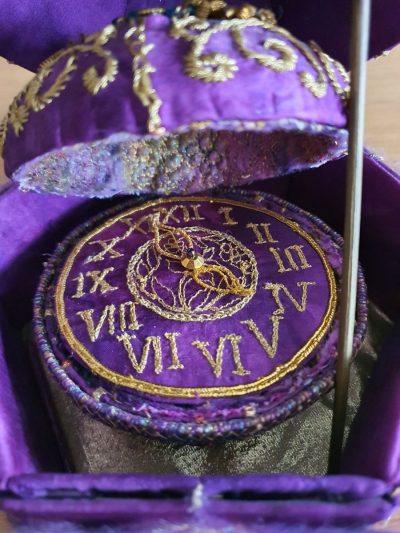
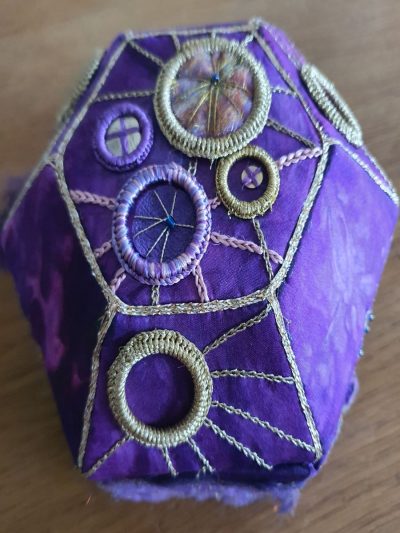
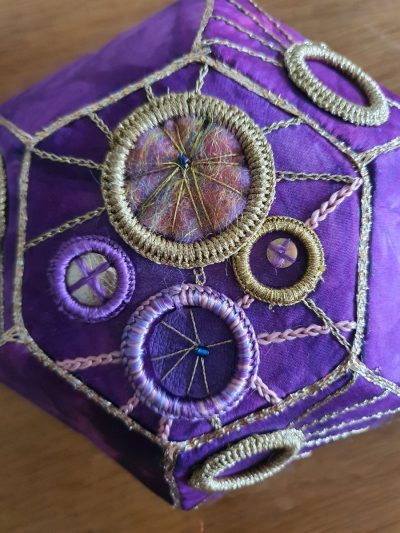
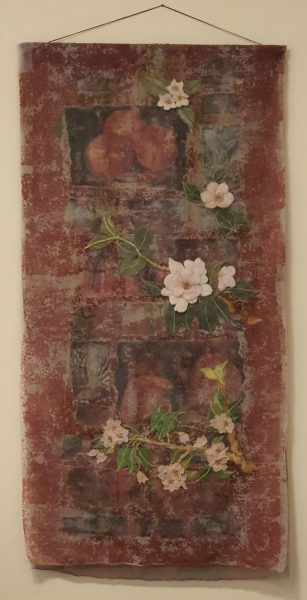
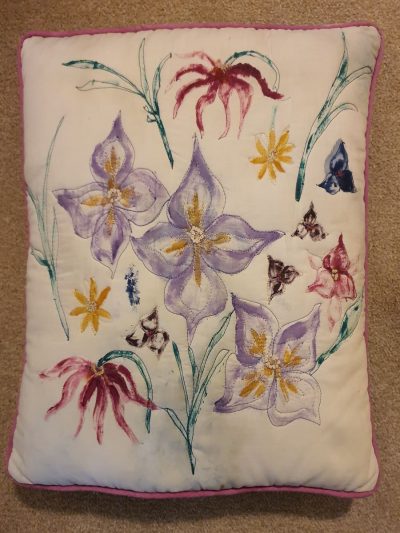
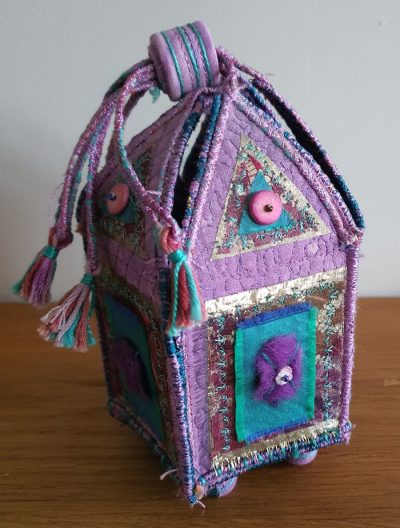
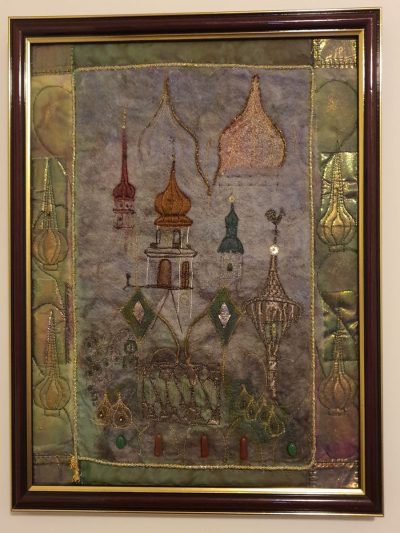
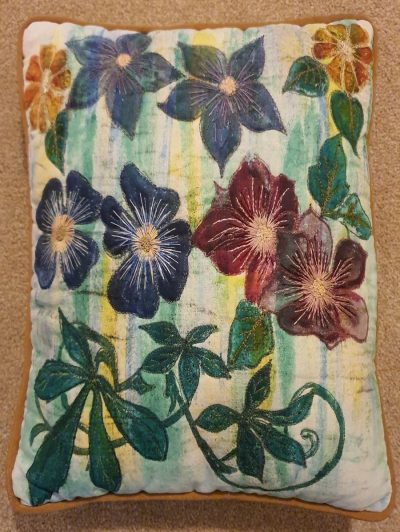 The Worthing Panel (below) can be found in the entrance of Worthing Hospital. Viviane coordinated many detailed contributions from members, which were combined into her design. There is so much detail in the panel that it deserves a whole news post in its’ own right. Photographing it during the day wasn’t very successful due to the lights in the WH Smiths shop oppositive which cast reflections on the glass (which is why it is shown here at a strange angle). I will go back another time after 8m when the shop is closed, when I hope to get some better photographs that show the details. In the meantime, here is a ‘taster’.
The Worthing Panel (below) can be found in the entrance of Worthing Hospital. Viviane coordinated many detailed contributions from members, which were combined into her design. There is so much detail in the panel that it deserves a whole news post in its’ own right. Photographing it during the day wasn’t very successful due to the lights in the WH Smiths shop oppositive which cast reflections on the glass (which is why it is shown here at a strange angle). I will go back another time after 8m when the shop is closed, when I hope to get some better photographs that show the details. In the meantime, here is a ‘taster’.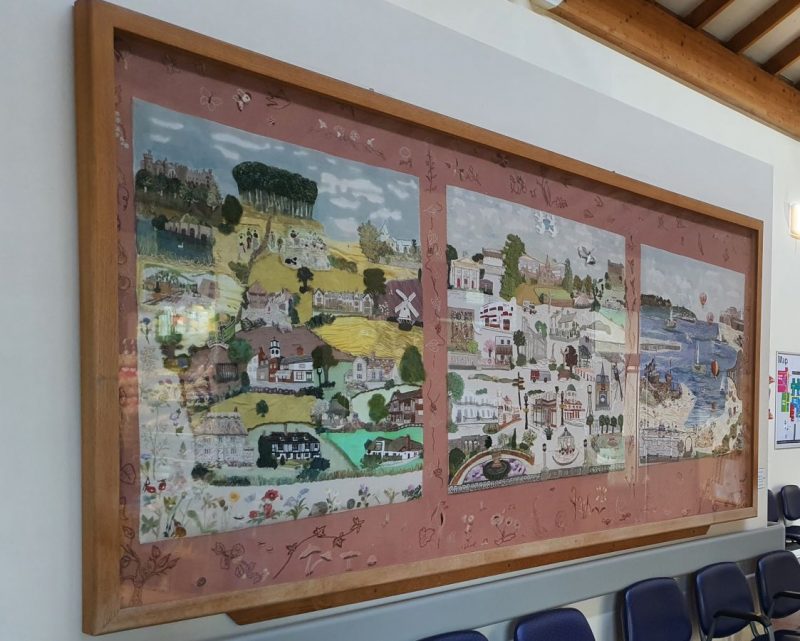
Month: March 2023
Eileen Amos
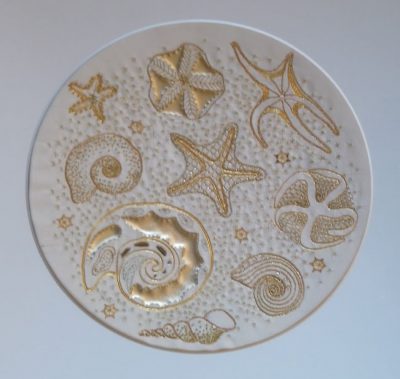 Eileen Amos was a member of our group for many years, and members will have read this tribute to her in our newsletter, written by Jan Angove. Rather than squeeze photos of Eileen’s work into the newsletter, we thought we would put them here on the website so that members can see them at a better resolution, and remind themselves of her talent.
Eileen Amos was a member of our group for many years, and members will have read this tribute to her in our newsletter, written by Jan Angove. Rather than squeeze photos of Eileen’s work into the newsletter, we thought we would put them here on the website so that members can see them at a better resolution, and remind themselves of her talent.
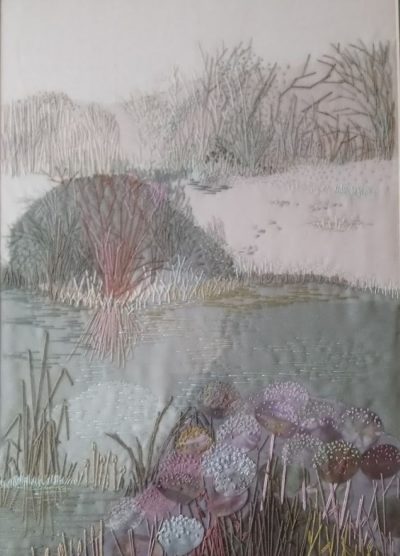 Jan wrote: I met Eileen in 1985. She ran a group “Dressmaking for the Blind” at Northbrook College. She needed an extra pair of hands so I volunteered. As our ladies had limited sight our task was to think of ways to make paper dress patterns usable by highlighting notches with textured stick on dots, checking the layout before the fabric was cut, and threading machine and hand sewing needles, as well as undoing the occasional seam! I learnt a lot about how to fit clothes from Eileen, she was a superb dressmaker. The group ran for many years and was fun as well as providing a meeting place for ladies who shared a love of sewing. The finished garments were worn with such pride.
Jan wrote: I met Eileen in 1985. She ran a group “Dressmaking for the Blind” at Northbrook College. She needed an extra pair of hands so I volunteered. As our ladies had limited sight our task was to think of ways to make paper dress patterns usable by highlighting notches with textured stick on dots, checking the layout before the fabric was cut, and threading machine and hand sewing needles, as well as undoing the occasional seam! I learnt a lot about how to fit clothes from Eileen, she was a superb dressmaker. The group ran for many years and was fun as well as providing a meeting place for ladies who shared a love of sewing. The finished garments were worn with such pride.
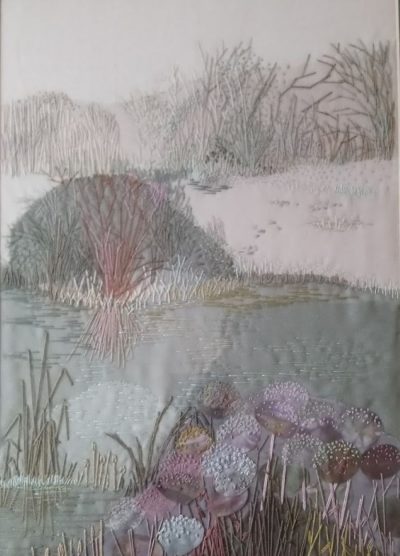 Eileen trained at Brighton College of Art, and then taught dressmaking at Tunbridge Wells College of Art before the family moved to Rustington.
Eileen trained at Brighton College of Art, and then taught dressmaking at Tunbridge Wells College of Art before the family moved to Rustington.
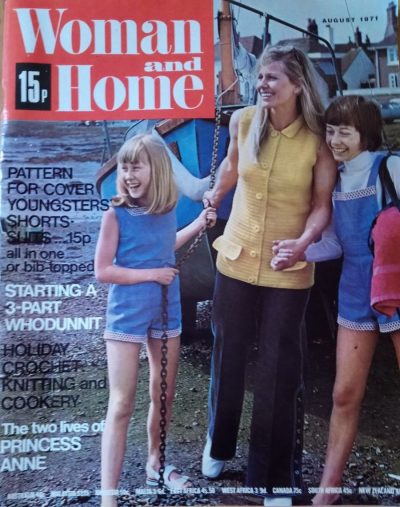 She made some of the examples of sewing techniques for books on dressmaking produced by Ann Ladbury in conjunction with her TV series in the 70’s. Sarah, Eileen’s daughter says she and her sister Karen modelled some of the children’s clothes Eileen made for Woman and Home magazine. There were many clients for whom Eileen would make beautiful clothes. She also made garments for the weaver Geraldine St Aubyn Hubbard, a textile artist based near Chichester. The cloth (silk, cashmere and wool) was woven, then passed to Eileen who made it into loose fitting couture garments destined for London boutiques. This partnership lasted many years.
She made some of the examples of sewing techniques for books on dressmaking produced by Ann Ladbury in conjunction with her TV series in the 70’s. Sarah, Eileen’s daughter says she and her sister Karen modelled some of the children’s clothes Eileen made for Woman and Home magazine. There were many clients for whom Eileen would make beautiful clothes. She also made garments for the weaver Geraldine St Aubyn Hubbard, a textile artist based near Chichester. The cloth (silk, cashmere and wool) was woven, then passed to Eileen who made it into loose fitting couture garments destined for London boutiques. This partnership lasted many years.
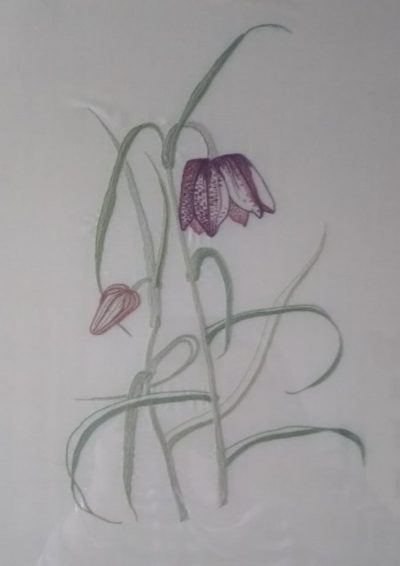 After Eileen gave up some of her dressmaking she turned to hand and machine embroidery on silk which she had painted, producing exquisite pictures and bags. She was a member of the Embroiderer’s Guild for many years, and of Pizazz and exhibited with them. Eventually mobility issues meant she had to give up attending meetings.
After Eileen gave up some of her dressmaking she turned to hand and machine embroidery on silk which she had painted, producing exquisite pictures and bags. She was a member of the Embroiderer’s Guild for many years, and of Pizazz and exhibited with them. Eventually mobility issues meant she had to give up attending meetings.
Over the years I kept in touch with Eileen and we would meet occasionally for coffee and a chat about all things “sewing”.
Jan Angove
Batik talk by Rosi Robinson
 Thank you to Maria who wrote this description of the talk given by Rosi Robinson at our March meeting.
Thank you to Maria who wrote this description of the talk given by Rosi Robinson at our March meeting.
On Tuesday 14th March Rosi gave us a very comprehensive talk about her work as a batik artist, teacher, lecturer and author. She retired from teaching in 2013 and now lectures and teaches batik workshops throughout the world. Rosi is a member of the Sussex Guild, the Batik Guild and Craft Nova Scotia Canada. In 2022 Rosi was filmed in her studio for a feature on Bargain Hunt when they were filming at the Ardingly Antiques Fair. They filmed for two and a half hours for a four minute slot. Following the exposure on National TV Rosi was inundated with over 60 orders for her work.
 Rosi told us that batik is a traditional resist technique of decorating fabric where wax is applied to white fabric to resist colourful dyes. She uses this technique to produce pictures that are often mistaken for watercolour paintings. Rosi started her talk by showing various batiks collected from around the world and explaining the various techniques used. As these were then passed around the room there was a “buzz” as everyone touched and discussed the various fabrics.
Rosi told us that batik is a traditional resist technique of decorating fabric where wax is applied to white fabric to resist colourful dyes. She uses this technique to produce pictures that are often mistaken for watercolour paintings. Rosi started her talk by showing various batiks collected from around the world and explaining the various techniques used. As these were then passed around the room there was a “buzz” as everyone touched and discussed the various fabrics.
 Rosi then demonstrated the technique by applying hot wax to fabric which works as a resist. She demonstrated different waxing tools such as cantings (tjantings), brushes and caps (tjaps). She then painted on the dyes. The waxed areas resist the dye and remain the original colour. Only unwaxed areas take up the dye. Start with the lightest colours, gradually building up the tones to the darker colours. The fabric has to dry before the next layer of wax is added. Once completed a hot iron is used to remove most of the wax and the item is then boiled or dry cleaned.
Rosi then demonstrated the technique by applying hot wax to fabric which works as a resist. She demonstrated different waxing tools such as cantings (tjantings), brushes and caps (tjaps). She then painted on the dyes. The waxed areas resist the dye and remain the original colour. Only unwaxed areas take up the dye. Start with the lightest colours, gradually building up the tones to the darker colours. The fabric has to dry before the next layer of wax is added. Once completed a hot iron is used to remove most of the wax and the item is then boiled or dry cleaned.
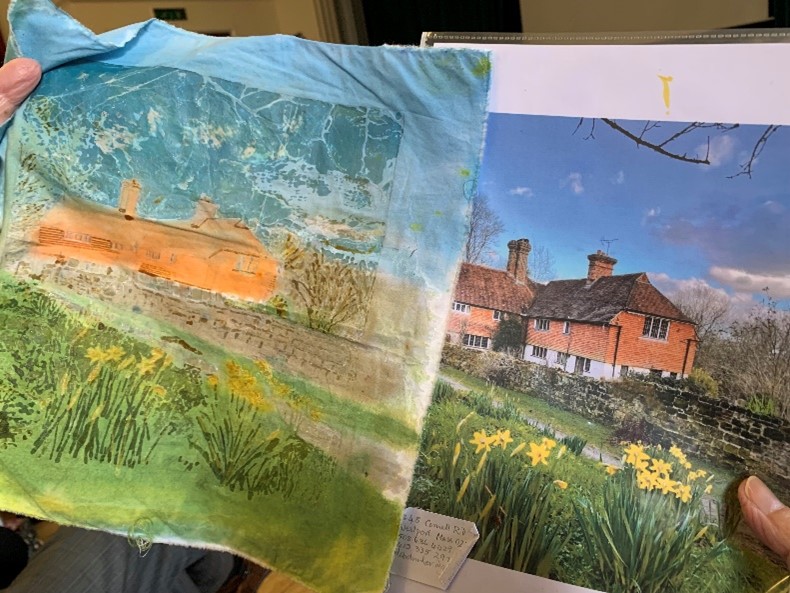
Rosi then shared a slide show of lots of stunning examples of her own work.
Several members have already attended a workshop with Rosi and others have expressed an interest in attending one. We will be looking at options for 2024.

